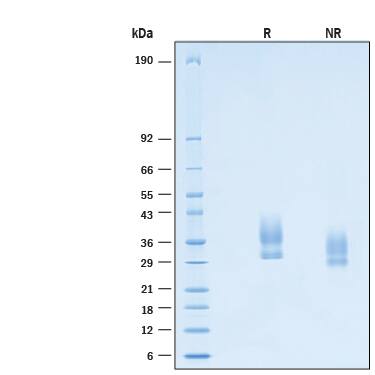Recombinant Cyno Lymphotoxin beta R/TNFRSF3 His Protein, CF
R&D Systems, part of Bio-Techne | Catalog # 11152-LR
Cynomolgus Monkey His-tag

Key Product Details
Product Specifications
Source
Chinese Hamster Ovary cell line, CHO-derived cynomolgus monkey Lymphotoxin beta R/TNFRSF3 protein
Ser28-Met227, with a C-terminal 6-His tag
Ser28-Met227, with a C-terminal 6-His tag
Purity
>95%, by SDS-PAGE visualized with Silver Staining and quantitative densitometry by Coomassie® Blue Staining.
Endotoxin Level
<0.10 EU per 1 μg of the protein by the LAL method.
N-terminal Sequence Analysis
Ser28 & Gln29 & Gln 31
Predicted Molecular Mass
26 kDa
SDS-PAGE
29-41 kDa, under reducing conditions.
Activity
Measured by its ability to inhibit Recombinant Human Lymphotoxin
alpha1/ beta2
(Catalog #
8884-LY) induced IL-8 secretion in A375 human melanoma cells. The ED50
for this effect is 0.125-1.50 μg/mL.
Scientific Data Images for Recombinant Cyno Lymphotoxin beta R/TNFRSF3 His Protein, CF
Recombinant Cynomolgus Monkey Lymphotoxin betaR/TNFRSF3 His-tag Protein Bioactivity.
Recombinant Cynomolgus Monkey Lymphotoxin betaR/TNFRSF3 His-tag Protein (Catalog # 11152-LR) inhibits Recombinant Human Lymphotoxin alpha1/ beta2 (8884-LY) induced IL-8 secretion in A375 human melanoma cells. The ED50 for this effect is 0.125-1.50 μg/mL.Recombinant Cynomolgus Monkey Lymphotoxin betaR/TNFRSF3 His-tag Protein SDS-PAGE.
2 μg/lane of Recombinant Cynomolgus Monkey Lymphotoxin betaR/TNFRSF3 His-tag Protein (Catalog # 11152-LR) was resolved with SDS-PAGE under reducing (R) and non-reducing (NR) conditions and visualized by Coomassie® Blue staining, showing bands at 29-41 kDa.Formulation, Preparation and Storage
11152-LR
| Formulation | Lyophilized from a 0.2 μm filtered solution in PBS with Trehalose. |
| Reconstitution | Reconstitute at 500 μg/mL in PBS. |
| Shipping | The product is shipped at ambient temperature. Upon receipt, store it immediately at the temperature recommended below. |
| Stability & Storage | Use a manual defrost freezer and avoid repeated freeze-thaw cycles.
|
Background: Lymphotoxin beta R/TNFRSF3
References
- Crowe, P.D. et al. (1994) Science 264:707.
- Force, W.R. et al. (1995) J. Immunol. 155:5280.
- McCarthy, D.D. (2006) Immunol. Res. 35:41.
- Tumanov, A.V. et al. (2007) Curr. Mol. Med. 7:567.
- Boehm, T. et al. (2003) J. Exp. Med. 198:757.
- Wolf, M.J. et al. (2010) Oncogene 29:5006.
- Bista, P. et al. (2010) J. Biol. Chem. 285:12971.
- van de Pavert, S.A. et al. (2010) Nat. Rev. Immunol. 10:664.
- Mouri, Y. et al. (2011) J. Immunol. 186:5047.
- Vondenhoff, M.F. et al. (2009) J. Immunol. 182:5439.
- Haybaeck, J. et al. (2009) Cancer Cell 16:295.
Long Name
Lymphotoxin beta Receptor
Alternate Names
LTBR, LymphotoxinbR, TNF RIII, TNF Rrp, TNFRSF3
Entrez Gene IDs
Gene Symbol
LTBR
UniProt
Additional Lymphotoxin beta R/TNFRSF3 Products
Product Documents for Recombinant Cyno Lymphotoxin beta R/TNFRSF3 His Protein, CF
Product Specific Notices for Recombinant Cyno Lymphotoxin beta R/TNFRSF3 His Protein, CF
For research use only
